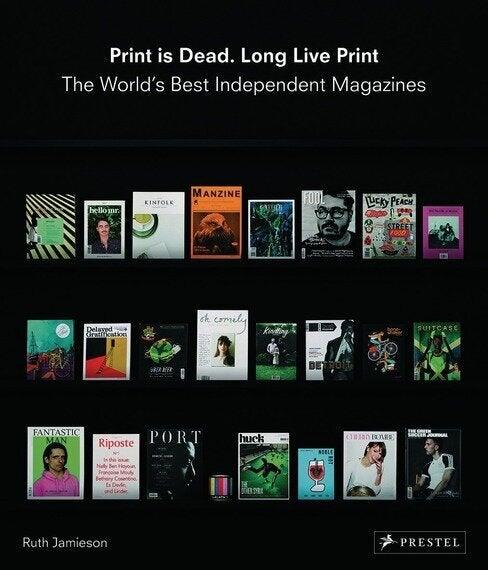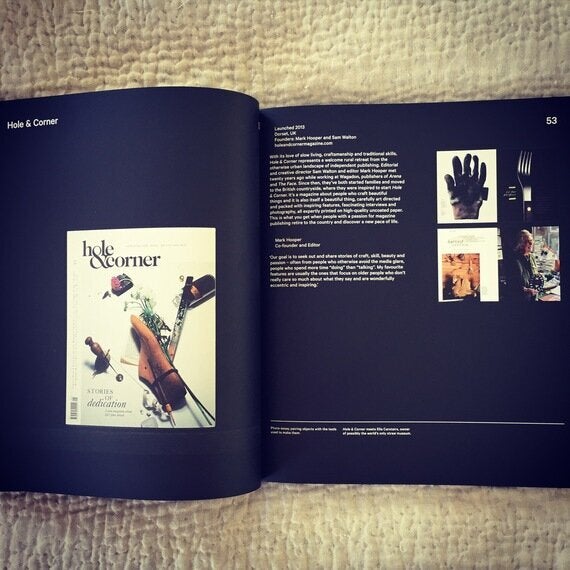
We are witnessing strange times indeed in the world of publishing.
The ongoing decline in many mainstream print titles has been punctuated by high profile closures, 'mobile-first' strategies and a lot of empty talk about 'content'. When Newsweek signed off the last paper version of their magazine in December 2012, they chose the climactic hashtag '#LASTPRINTISSUE' as their coverline. But, while many in print publishing will remember these days as the worst of times, for others they are the best of times. As the new book 'Print is Dead. Long Live Print: The World's Best Independent Magazines' by Ruth Jamiesen (Prestel Publishing) makes clear, we are paradoxically seeing a renaissance in independent publishing.
"There's still such a hunger and thirst for the printed product," says Wallpaper* Editor-in-Chief Tony Chambers. "There's evidence everywhere - look at how many magazines there are in newsagents and bookshops; more than ever."

Indeed, you'll even find print copies of Newsweek, having been resurrected in March 2014, under the new ownership of IBT Media. So far, so promising. Monocle's founder Tyler Brulé (who has recently announced he is opening an independent newsagents himself) is bullish in his championing of print. "Show a commitment to paper, and why it's unique in the media landscape, and savvy advertisers will line up," Brulé noted on a recent episode of The Stack, the show he hosts on his own digital radio station, Monocle24.
The last part of that sentence is just as crucial as the first. What we are witnessing is a rise in magazines carving out a new place for themselves in the modern landscape. So, while that does include paper as a core component, it can't be the entire story. In this post-digital age, magazines are having to find new revenue streams as the old advertising page rate model declines. Monocle is a prime example: it has branched out into digital radio, online paywalls and an approach to advertising that is closer to corporate sponsorship.
This is surely better than the alternative. Many 'old media' titles have shot themselves in the foot by ceding editorial independence in order to keep advertisers sweet. But by losing their voice and their integrity, they are also losing the readers they rely on to keep their ad rates high. People can spot insincerity a mile off, and if you treat your audience with disrespect, they'll vote with their feet.
So the challenge for new titles is to seek different routes to funding that will ensure they don't have to compromise on their editorial. 'Native Advertising' has been the key buzzword over the past year - in other words, working with brands who share your values in more of an equal (and transparent) relationship. Rather than inserting those terrible advertorials that no-one but the client reads, publishers are now working with likeminded brands to help them on genuine editorial assignments. For instance, if you're going to do a feature on mountaineering, why not ask Land Rover to help get your team there, and make a decent 'behind the scenes' film for their website en route?
Likewise, sponsored events, talks and workshops can help to extend the reach of a magazine brand via a natural progression of their editorial strategy. Wired now hosts a series of conferences that brings their subject matter to life for readers and provides a revenue stream that supports its print and online ventures.
"These magazine makers aren't just creative - they are entrepreneurs, and they are reinventing an industry," says Jamiesen. (Full disclosure here: the magazine I edit, Hole & Corner, is one of the indie titles listed in her book - and our revenue comes not only from the old print ad model, but also from retail, organising events, partnering with and producing content for likeminded brands and through crowd funding.)

So, while some lament the death of 'old media', they have in many ways only themselves to blame if they don't heed the evidence of smaller, more nimble rivals that have used new media techniques to reach their audiences in efficient and profitable ways, producing a model that is both sustainable and relevant to a modern audience.
Jamiesen further notes how "innovation and lateral thinking" are carving out a new business model for the magazine industry, identifying new revenue streams by developing titles into lifestyle brands. That doesn't mean they have to lose what makes their paper offerings unique in the first place - far from it. One genuine quote from a senior editorial executive on a newspaper - who will remain nameless - sums up the muddled attempt to embrace 'new thinking' by old media: "Content is now central to everything we do as a brand," they blithely announced. Which rather begs the question of what they used to fill all those column inches with before the digital marketing gurus came on board...
So: when it comes to revenue streams, to reaching your audience in new ways and engaging them through multiple channels - think outside the box by all means. But don't forget the box is what got you an audience in the first place.